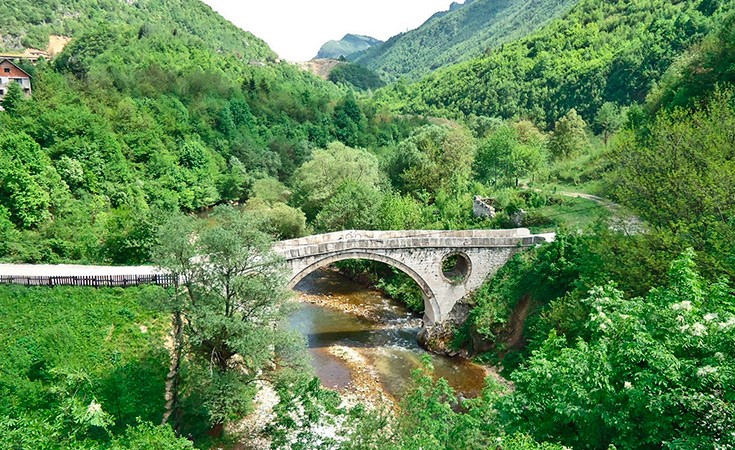
The Goat's Bridge is located in the canyon of the river Miljacka, three kilometers east from the city of Sarajevo. The bridge actually used to connect two sides of land with a road called "Constantinople's road", which, during the Ottoman rule, connected Sarajevo to the eastern parts of the empire, all the way to Constantinople. It was also the only road that led to the exit from Sarajevo.
The data regarding the bridge construction is scarce. The bridge is 42 meters long and 4.75 meters wide. The span of the vault is 17.5 m and the bridge has one arch with two circular openings (auxiliary openings in case the river floods). The bridge is made of limestone and tuff.
Two folk legends are associated with the construction of the bridge. According to the first legend, Kecedji Mehmed, a shepherd who guarded his goats, noticed that the goats remained unusually long around one bush near the river. When he looked under that bush, he found a cup full of gold. With this money he paid for his education, and when he became a respectable and wealthy man in the empire, he decided to build a bridge over Miljacka river, in the same place where his goats pointed to a cup of treasures.
Another legend is telling a story about two brothers, Sinan and Mehmed, who worked as shepherds near Miljacka river. Legend has it that one of their goats, while digging through the bushes, dug up a cup with hidden treasure. When the two brothers saw this, they vowed to build a bridge and a mosque out of this gold. Kecedji Sinan mosque still exists in Sarajevo city district called Bistrik, and the bridge is symbolically called The Goat’s Bridge.
However, it is considered that this bridge was built during the rule of the great vizier Mehmed-pasha Sokolović (he was the grand vizier from 1565 to 1579), along with massive construction of new road network in Sarajevo.
The bridge was used to escort pilgrims to Hajj and Jerusalem, and was also used to welcome viziers from Constantinople. The only vizier, who did not respect Bosnian tradition at the time was Alipas Verenda – he refused to have the welcoming coffee drink on the Goat’s bridge. As the locals denounced this insult, they banished the vizier after two years, and he did not have the opportunity to drink even, a so called "sikterusa" – a coffee that is usually served at the end of the meal. Once it is served, this means that you should soon leave your host’s house.
When one Bosnian man was once asked who was the best vizier, he replied: "The one who left Constantinople and never arrived to Bosnia".
On the way to Goat’s Bridge visitors will see two burial places of Sheikh Ahmed and Abdalmahmut, which are over 250 years old. You will also find Abu Hayat wellhead which, according to the legend, never dried, and was discovered approx. 400 years ago.
The Goat’s Bridge area is a place where locals come to relax and enjoy the nature.